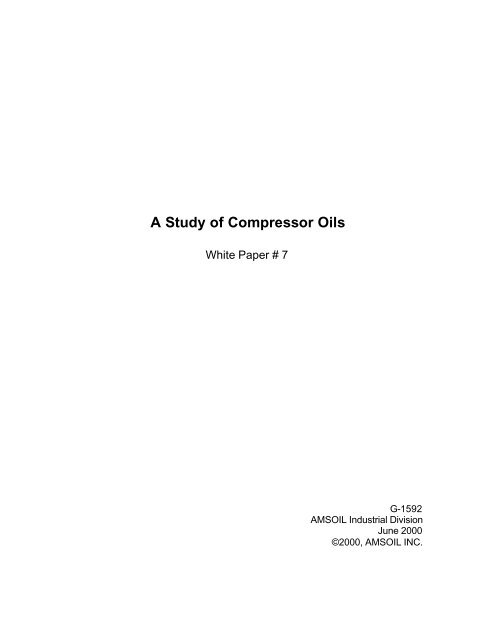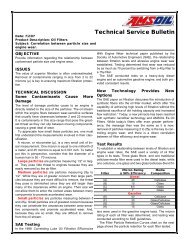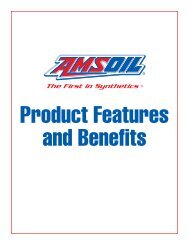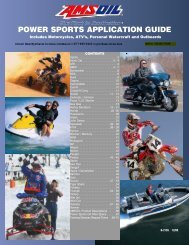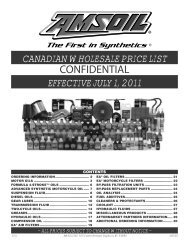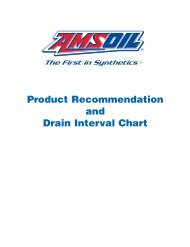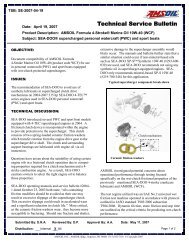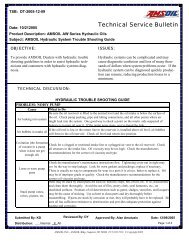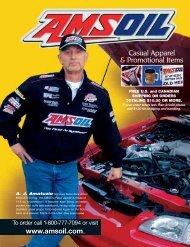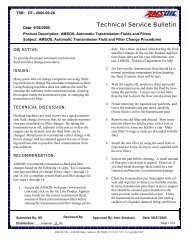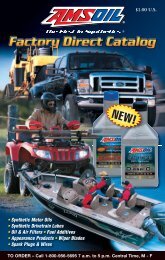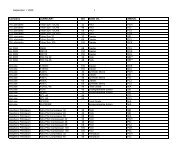A Study of Compressor Oils - AMSOIL Synthetic Motor Oil
A Study of Compressor Oils - AMSOIL Synthetic Motor Oil
A Study of Compressor Oils - AMSOIL Synthetic Motor Oil
You also want an ePaper? Increase the reach of your titles
YUMPU automatically turns print PDFs into web optimized ePapers that Google loves.
A <strong>Study</strong> <strong>of</strong> <strong>Compressor</strong> <strong><strong>Oil</strong>s</strong><br />
White Paper # 7<br />
G-1592<br />
<strong>AMSOIL</strong> Industrial Division<br />
June 2000<br />
©2000, <strong>AMSOIL</strong> INC.
Table <strong>of</strong> Contents<br />
OVERVIEW Page 3<br />
PURPOSE Page 3<br />
METHOD Page 3<br />
SCOPE Page 3<br />
SYNTHETIC COMPRESSOR LUBRICANTS_______________________ Page 4<br />
DESIRED PERFORMANCE CHARACTERISTICS AND RESULTS Page 4<br />
OXIDATION RESISTANCE Page 5<br />
Rotary Bomb Oxidation Test (RBOT) ASTM D-2272 Page 5<br />
Modified Universal Oxidation/Thermal Stability Test ASTM D-4871 Page 5<br />
WATER RESISTANCE Page 7<br />
Hydrolytic Stability ASTM D-2619 Page 7<br />
Demulsibility ASTM D-1401 Page 9<br />
Rust Prevention in <strong>Synthetic</strong> Sea Water ASTM D-665B Page 10<br />
FOAM STABILITY ASTM D-892 Page 11<br />
ANTI-WEAR Page 11<br />
Wear Preventive Characteristics <strong>of</strong> Lubricating Fluid ASTM D-4172 Page 12<br />
COPPER CORROSION ASTM D-130 Page 12<br />
VISCOSITY INDEX ASTM D-2270 Page 13<br />
VISCOSITY ASTM D-445 Page 13<br />
POUR POINT ASTM D-97 Page 14<br />
PRICING Page 15<br />
PAIL PRICING Page 15<br />
DRUM PRICING Page 15<br />
TEST RESULTS SUMMARY Page 16<br />
DISCUSSION Page 18<br />
AFFIDAVIT OF TEST RESULTS Page 19<br />
AFFIDAVIT OF PRICE Page 20<br />
BATCH NUMBERS OF COMPRESSOR OILS TESTED Page 21<br />
2
Overview<br />
Compressed air is <strong>of</strong>ten a critical part <strong>of</strong> manufacturing operations and therefore good, reliable<br />
compressor operation is always necessary. <strong>Compressor</strong> oil is an important part <strong>of</strong> the equation<br />
and the lubricants market for compressors is very complex with several products being available.<br />
<strong>Compressor</strong> oil is not governed by an organization and there are no <strong>of</strong>ficial performance<br />
standards. Therefore, responsibility for marketing a satisfactory product has been up to the<br />
individual oil companies with performance requirements determined to a varying degree by the<br />
compressor original equipment manufacturer or OEM.<br />
<strong>Compressor</strong> OEMs help eliminate some confusion by publishing minimum oil specifications<br />
required for their units. They also frequently market their own brand <strong>of</strong> compressor oil and have<br />
<strong>of</strong>ten been able to tie warranty requirements to the use <strong>of</strong> this oil. Since there is not an <strong>of</strong>ficial<br />
standard for compressor oil performance, end users find comfort in using manufacturer<br />
recommended oil. Unfortunately, in many cases the price <strong>of</strong> these oils is unnecessarily inflated<br />
and is frequently exorbitant. In addition, these oils <strong>of</strong>ten do not have the best performance<br />
characteristics that are available on the market.<br />
OEM branded oils are very expensive primarily for two reasons. One reason is multiple step<br />
distribution <strong>of</strong> two to four steps before the customer receives the product. The second reason is<br />
that since warranties are <strong>of</strong>ten tied to the use <strong>of</strong> OEM branded lubricants, the customer must pay<br />
the price demanded by the OEM if they hope to avoid having their warranty coverage challenged.<br />
As a result <strong>of</strong> these two circumstances, pricing for OEM compressor lubricants is significantly<br />
higher than even oil company premium products.<br />
Purpose<br />
The purpose <strong>of</strong> this paper is to inform consumers about the performance and cost differences<br />
between OEM branded and popular aftermarket compressor oils. Critical performance criteria<br />
and retail pricing <strong>of</strong> some <strong>of</strong> the major compressor oils available in the marketplace has been<br />
evaluated.<br />
Method<br />
The testing by which these oils are evaluated is done in accordance with ASTM (American<br />
Society for Testing and Materials) procedures. All testing was done in duplicate and the average<br />
<strong>of</strong> the results is reported. The results <strong>of</strong> these tests can be duplicated and verified by laboratories<br />
that conduct these ASTM tests. A notarized affidavit certifying the results are correct is included<br />
in the appendix. <strong>Compressor</strong> oil pricing was determined by contacting the manufacturer or the<br />
distributor for the subject lubricant and requesting a quote on a five-gallon pail and a fifty-five<br />
gallon drum. Price quotes obtained are listed in the pricing section. A notarized affidavit attesting<br />
to the pricing obtained is included in the appendix.<br />
Scope<br />
This paper is focused on rotary screw type compressors and synthetic oils. Rotary screw<br />
compressors are widely used in all types <strong>of</strong> industries and synthetic compressor oils are<br />
recognized as superior to mineral based compressor oils by compressor manufacturers as well<br />
as most oil companies and consumers. Therefore, synthetic oils, with the exception <strong>of</strong> Sullair<br />
SRF 1/4000, were the only oils tested. Sullair SRF 1/4000 is a highly refined mineral oil and was<br />
included for comparison.<br />
The testing conducted is intended to address main lubricating requirements <strong>of</strong> rotary screw<br />
compressors. While there are many tests by which oils could be measured, the information<br />
provided by the tests included in this paper gives a well-rounded view <strong>of</strong> the compressor oil’s<br />
performance.<br />
3
<strong>Synthetic</strong> <strong>Compressor</strong> Lubricants<br />
The synthetic compressor oils tested are formulated using polyalphaolephins (PAO), esters and<br />
polyglycols. These synthetic oil chemistries are widely available and well accepted for use in<br />
compressor applications.<br />
1. PAO (polyalphaolephins) synthetic compressor oils are commonly used in rotary<br />
screw compressors as well as vane and reciprocating compressors. These oils<br />
provide long life in screw compressors <strong>of</strong>ten exceeding 8,000 hours under normal<br />
operating conditions. PAOs have excellent water resistance and excellent thermal<br />
and oxidative stability. They can be used in wide ranging operating temperatures<br />
and they have excellent cold temperature properties. They are compatible with most<br />
seals, paints and plastics as well as petroleum and ester type compressor oils.<br />
PAOs are also available in food grade. PAOs are not compatible with polyglycol type<br />
compressor oils. PAOs are typically less expensive the polyglycols and esters.<br />
2. <strong>Synthetic</strong> ester based compressor oils are commonly found in reciprocating<br />
compressor applications because <strong>of</strong> their low carbon forming tendencies. They are<br />
also used in rotary screw and vane compressors. <strong>Synthetic</strong> esters have a long life in<br />
rotary screw compressors, <strong>of</strong>ten exceeding 8,000 hours. Some synthetic ester oils<br />
are aggressive toward seals, paints and plastics and these compatibilities should be<br />
checked. Most synthetic esters used for compressors have good water resistance<br />
and excellent thermal and oxidative stability. They are compatible with PAOs and<br />
petroleum-based products. They may not be compatible with polyglycol-based<br />
compressor oils. These oils are typically more expensive than PAOs, but less<br />
expensive than polyglycols.<br />
3. Polyglycol synthetics are commonly used in rotary screw compressors. These oils<br />
have a long life <strong>of</strong>ten exceeding 8,000 hours under normal operating conditions and<br />
are <strong>of</strong>ten used in applications that compress process gasses, as they do not readily<br />
absorb these gasses. Polyglycol oils have good thermal and oxidative stability and<br />
they have fair water resistance. They exhibit good compatibility with seals, paints,<br />
and plastics. These oils, including Sullair Sullube 32 and Ingersoll-Rand SSR<br />
Ultra-Coolant, are generally not compatible with other oils. In addition, they are<br />
typically very expensive.<br />
Viscosity in all lubricated equipment is an important consideration. Generally, rotary screw<br />
compressors use an ISO-46 and sometimes an ISO-32 compressor oil.<br />
Desired Performance Characteristics and Results<br />
<strong><strong>Oil</strong>s</strong> used in rotary screw compressors operate in severe environments. The oil in the<br />
compression chamber is exposed to high heat as well as moisture. The oil is further exposed to<br />
high volumes <strong>of</strong> oxygen and constant churning. The oil is expected to lubricate the screws and<br />
bearings for extended periods <strong>of</strong> time (up to 8,000 hours). In view <strong>of</strong> the basic conditions in<br />
which rotary screw compressor oil operates, the oil needs to perform well in the following areas:<br />
4
Oxidation Resistance<br />
The compressor oil gets hot and is exposed to high volumes <strong>of</strong> air. This heat and air combination<br />
increases the rate <strong>of</strong> lubricant degradation through oxidation. The evaluated oils were subjected<br />
to two oxidation tests.<br />
Rotary Bomb Oxidation Test (RBOT) ASTM D-2272<br />
The Rotary Bomb Oxidation Test is a rapid method <strong>of</strong> comparing the oxidation life <strong>of</strong> lubricants<br />
similar formulations. The bomb is initially charged with 50 grams <strong>of</strong> test oil and 5 grams <strong>of</strong><br />
distilled water. A copper catalyst is added, and the bomb is pressurized with oxygen to 90 PSI at<br />
room temperature and submerged into a 150º C temperature bath. The bath temperature causes<br />
this pressure to increase to approximately 200 PSI. The bomb is rotated and as oxidation occurs,<br />
the pressure drops. The usual failure point is taken as a 25 PSI drop from the maximum pressure<br />
attained at 150º C. The results are reported as the number <strong>of</strong> minutes to the 25 PSI loss.<br />
<strong>Oil</strong> Life in Minutes<br />
0 500 1000 1500 2000 2500 3000<br />
SUMMIT SH-46<br />
2486<br />
LeROI SSL-46<br />
QUINCY QUINSYN<br />
<strong>AMSOIL</strong> PCI<br />
1868<br />
1997<br />
2155<br />
G-D AEON 9000 SP<br />
MOBIL RARUS 1024<br />
1620<br />
1615<br />
ANDEROL 3046<br />
SULLAIR SRF 1/4000<br />
1147<br />
1327<br />
I-R SSR COOLANT<br />
904<br />
SULLAIR SULLUBE 32<br />
I-R ULTRA COOLANT<br />
691<br />
690<br />
Higher is Better<br />
KAESER S-460<br />
244<br />
Modified Universal Oxidation/Thermal Stability Test ASTM D-4871<br />
This universal test allows for the examination <strong>of</strong> oxidation stability under a prescribed condition.<br />
This test was conducted with a copper and iron catalyst since these components are <strong>of</strong>ten found<br />
in compressors. The temperature was elevated to increase the rate <strong>of</strong> oxidation and shorten the<br />
duration <strong>of</strong> the test. This oxidation test has been modified to the following conditions:<br />
1) 192 ppm (parts per million) <strong>of</strong> an iron/copper catalyst<br />
2) Test temperature is 160° C<br />
3) Test time <strong>of</strong> 168 hours<br />
4) 50 grams <strong>of</strong> oil<br />
5) 10 liters <strong>of</strong> air per hour<br />
5
As the oxidation <strong>of</strong> the oil occurs, the viscosity and acid values increase. These values are<br />
reported in the charts below.<br />
Viscosity Change<br />
0.00% 20.00% 40.00% 60.00% 80.00% 100.00% 120.00%<br />
KAESER S-460<br />
SULLAIR SRF 1/4000<br />
ANDEROL 3046<br />
LeROI SSL-46<br />
<strong>AMSOIL</strong> PCI<br />
G-D AEON 9000 SP<br />
MOBIL RARUS 1024<br />
SULLAIR SULLUBE 32<br />
I-R ULTRA COOLANT<br />
SUMMIT SH-46<br />
QUINCY QUINSYN<br />
I-R SSR COOLANT<br />
0.26%<br />
4.09%<br />
5.11%<br />
5.39%<br />
6.79%<br />
7.66%<br />
8.29%<br />
12.88%<br />
17.18%<br />
Lower is Better<br />
65.31%<br />
93.62%<br />
103.78%<br />
Total Acid Values increase with oxidation. A lower change in TAN indicates less oxidation. TAN<br />
values were measured using ASTM D 664.<br />
Brand Product TAN Change<br />
KAESER S-460 0.02<br />
<strong>AMSOIL</strong> PCI 0.05<br />
COMP AIR LeROI SSL-46 PLUS 0.1<br />
SULLAIR SULLUBE 32 1.31<br />
SULLAIR SRF 1/4000 1.53<br />
MOBIL RARUS 1024 1.72<br />
INGERSOLL-RAND ULTRA COOLANT 1.81<br />
GARDNER DENVER AEON 9000 SP 1.90<br />
ANDEROL 3046 1.93<br />
QUINCY QUINSYN 1.96<br />
SUMMIT SH-46 2.10<br />
INGERSOLL-RAND SSR COOLANT 3.58<br />
6
Water Resistance<br />
When air or process gasses are compressed, moisture from humidity condenses and collects in<br />
the oil. Therefore, the oil needs to have good hydrolytic stability, demulsibility and rust protection.<br />
Good hydrolytic stability is important as this helps prevent the formation <strong>of</strong> acids and insures long<br />
lubricant life.<br />
Demulsibility is the oil’s ability to separate from water. This is important because it allows for<br />
water to be drained from the oil sump. Water is a poor lubricant and water mixed in with oil<br />
(emulsified) can cause thinning <strong>of</strong> the oil and premature wear. In addition, water mixed in with<br />
the oil can degrade the oil faster and shorten lubricant life.<br />
Since water is present, rust protection is important. <strong>Oil</strong> in its neat state, without additives, does a<br />
poor job <strong>of</strong> preventing rust. The oil needs to be formulated with additives that will inhibit the<br />
formation <strong>of</strong> rust. Rust is very abrasive and once formed on bearings and critical components it<br />
will significantly shorten component life.<br />
The candidate oils were subjected to three tests to measure hydrolytic stability, demulsibility and<br />
rust protection.<br />
Hydrolytic Stability ASTM D-2619<br />
This test is used to determine the stability <strong>of</strong> oils in contact with water. It depends upon the<br />
catalytic effect <strong>of</strong> copper at elevated temperatures in the presence <strong>of</strong> water to accelerate the rate<br />
<strong>of</strong> hydrolysis. This test is conducted by incorporating 75 grams <strong>of</strong> test oil along with 25 grams <strong>of</strong><br />
water and a polished, weighed copper strip catalyst sealed in a 6 ounce pressure type beverage<br />
bottle. The bottle is rotated at 5 rpm, end over end, for 48 hours in an oven at 200° F.<br />
At the end <strong>of</strong> the test, 6 parameters are measured. They are: acidity <strong>of</strong> water layer, TAN change<br />
<strong>of</strong> oil, insolubles present, percent change in oil viscosity, weight change <strong>of</strong> copper panel, and<br />
appearance <strong>of</strong> copper panel.<br />
The most significant parameters are acidity <strong>of</strong> water, appearance <strong>of</strong> copper panel, and weight<br />
loss <strong>of</strong> copper panel. The other parameters importance depends on the amount <strong>of</strong> deviation from<br />
the initial measurements.<br />
The following chart shows the amount <strong>of</strong> acid in the water. A lower amount <strong>of</strong> acid is considered<br />
better. For reference, Denison HF-O, a top tier hydraulic oil performance standard, has a<br />
maximum allowable limit <strong>of</strong> 4 mg KOH.<br />
Acidity <strong>of</strong> Water Layer<br />
Brand Product mg KOH (acid)<br />
INGERSOLL-RAND ULTRA COOLANT 0.02<br />
MOBIL MOBIL RARUS 1024 0.11<br />
SULLAIR SULLUBE 32 0.54<br />
ANDEROL ANDEROL 3046 0.76<br />
GARDNER DENVER AEON 9000 SP 0.88<br />
INGERSOLL-RAND SSR COOLANT 0.94<br />
KAESER S-460 1.01<br />
<strong>AMSOIL</strong> PCI 1.13<br />
SULLAIR SULLAIR SRF 1/4000 1.21<br />
QUINCY QUINSYN 1.48<br />
COMP AIR LeROI SSL-46 PLUS 2.40<br />
SUMMIT SUMMIT SH-46 3.25<br />
7
The following chart shows the amount <strong>of</strong> acidic change in the oil following the test. A high<br />
change is undesirable. Negative acid values can be attributed to acid neutralization by the<br />
catalyst and/or acid transfer to water.<br />
Brand Product TAN Change <strong>of</strong> <strong>Oil</strong><br />
COMP AIR LEROI SSL-46 PLUS -.05<br />
QUINCY QUINSYN -.01<br />
KAESER S-460 .01<br />
GARDNER DENVER AEON 9000 SP .01<br />
SULLAIR SULLAIR SRF 1/4000 .02<br />
<strong>AMSOIL</strong> PCI .03<br />
MOBIL MOBIL RARUS 1024 .06<br />
ANDEROL ANDEROL 3046 .07<br />
SUMMIT SUMMIT SH-46 .07<br />
SULLAIR SULLUBE 32 .11<br />
INGERSOLL-RAND ULTRA COOLANT .15<br />
INGERSOLL-RAND SSR COOLANT 1.49<br />
The following chart shows the amount <strong>of</strong> insolubles present after the test by percentage. A lower<br />
percentage is desired.<br />
Brand Product Insolubles<br />
MOBIL MOBIL RARUS 0.00%<br />
SUMMIT SUMMIT SH-46 0.00%<br />
INGERSOLL-RAND ULTRA COOLANT .002%<br />
INGERSOLL-RAND SSR COOLANT .003%<br />
ANDEROL ANDEROL 3046 0.01%<br />
SULLAIR SULLUBE 32 0.01%<br />
SULLAIR SULLAIR SRF 1/4000 0.01%<br />
<strong>AMSOIL</strong> PCI 0.019%<br />
QUINCY QUINSYN 0.02%<br />
KAESER S-460 0.02%<br />
GARDNER DENVER AEON 9000 SP 0.03%<br />
COMP AIR LeROI SSL-46 PLUS 0.05%<br />
8
This chart shows the change in viscosity that occurred during the test. Changes in viscosity can<br />
be attributed to water solubility <strong>of</strong> either the light or heavy components <strong>of</strong> the oil. Deviation from<br />
initial viscosity is undesirable.<br />
Brand Product %Change in Viscosity<br />
INGERSOLL-RAND SSR COOLANT -2.34%<br />
SUMMIT SUMMIT SH-46 -0.65%<br />
GARDNER DENVER AEON 9000 SP -0.27%<br />
<strong>AMSOIL</strong> PCI -0.06%<br />
MOBIL MOBIL RARUS 1024 -0.03%<br />
ANDEROL ANDEROL 3046 0.00%<br />
QUINCY QUINSYN 0.02%<br />
SULLAIR SULLAIR SRF 1/4000 0.03%<br />
KAESER S-460 0.11%<br />
COMP AIR LEROI SSL-46 PLUS 0.12%<br />
INGERSOLL-RAND ULTRA COOLANT 2.79%<br />
SULLAIR SULLUBE 32 4.03%<br />
Weight Change <strong>of</strong> Copper Panel<br />
Results: All oils did well on this test exhibiting a less than .06 mg/cm² weight change.<br />
Appearance <strong>of</strong> Copper Panel<br />
Results: All oils did well on this test achieving a “1b” or better rating.<br />
Demulsibility ASTM D-1401<br />
This test is used to determine the ability <strong>of</strong> hydraulic oils, steam turbine oils and many similar<br />
products to separate from water.<br />
In this test, 40 ml <strong>of</strong> distilled water and 40 ml <strong>of</strong> oil are measured into a properly cleaned 100 ml<br />
graduated cylinder and immersed in a bath at 130°F. The oil and water are mixed for 5 minutes<br />
at 1500 rpm with a special stirrer. The amounts <strong>of</strong> separated oil, water and emulsion are<br />
recorded at 5-minute intervals for up to one hour reported as ml oil/ ml water/ ml emulsion<br />
(minutes). Most specifications require separation, so that less than 3 ml <strong>of</strong> emulsion (cuff) remain<br />
after 30 minutes.<br />
Brand Product Demulsibility<br />
GARDNER DENVER AEON 9000 SP 40/40/0(5)<br />
COMP AIR LeROI SSL-46 PLUS 40/40/0(5)<br />
QUINCY QUINSYN 40/40/0(5)<br />
INGERSOLL-RAND SSR COOLANT 40/40/0(5)<br />
ANDEROL ANDEROL 3046 40/40/0(10)<br />
SUMMIT SUMMIT SH-46 40/40/0(10)<br />
<strong>AMSOIL</strong> PCI 40/40/0(15)<br />
KAESER S-460 40/40/0(15)<br />
MOBIL MOBIL RARUS 1024 40/40/0(15)<br />
SULLAIR SULLUBE 32 40/40/0(20)<br />
SULLAIR SULLAIR SRF 1/4000 40/40/0(45)<br />
INGERSOLL-RAND ULTRA COOLANT 0/30/50(65)<br />
9
Rust Prevention in <strong>Synthetic</strong> Sea Water ASTM D-665B<br />
This test is designed to measure the ability <strong>of</strong> industrial oils to prevent rusting under conditions <strong>of</strong><br />
water contamination. The test consists <strong>of</strong> stirring a mixture <strong>of</strong> 300 ml <strong>of</strong> water, either distilled or<br />
seawater, at 140° F for 24 hours. A special cylindrical steel test specimen made from #1028 cold<br />
finished carbon steel is polished and then completely immersed in the test fluid. At the<br />
conclusion <strong>of</strong> the 24-hour period the specimen is removed, washed with solvent and rated for<br />
rust. In order to pass the ASTM D-665 Rust Test, the specimen must be completely free from<br />
visible rust when examined without magnification under normal light.<br />
This test conducted in synthetic seawater is more severe than in distilled water. It helps identify<br />
the oils with superior rust protection.<br />
Brand Product Rust Prevention<br />
Procedure B<br />
<strong>AMSOIL</strong> PCI PASS<br />
COMP AIR LeROI SSL-46 PLUS PASS<br />
SULLAIR SULLAIR SRF 1/4000 PASS<br />
SUMMIT SUMMIT SH-46 PASS<br />
MOBIL MOBIL RARUS 1024 PASS<br />
ANDEROL ANDEROL 3046 FAIL<br />
INGERSOLL-RAND ULTRA COOLANT FAIL<br />
INGERSOLL-RAND SSR COOLANT FAIL<br />
QUINCY QUINSYN FAIL<br />
SULLAIR SULLUBE 32 FAIL<br />
GARDNER DENVER AEON 9000 SP FAIL<br />
KAESER S-460 FAIL<br />
10
Foam Stability ASTM D-892<br />
The oil in flooded rotary screw compressors experiences severe churning and foaming <strong>of</strong> the oil<br />
is likely to occur. Foam causes increased oxidation by exposing more <strong>of</strong> the surface area <strong>of</strong> the<br />
oil to oxygen. Foam also increases heat by acting like a blanket and not allowing the oil to<br />
dissipate the heat. Foam reduces the lubricating qualities <strong>of</strong> oil because the bubbles collapse<br />
and reduce the oil film in critical areas. The test oils were subjected to one test.<br />
This test method is used to evaluate oils operating in systems with high-speed gearing, highspeed<br />
bearings, high-volume pumping and splash lubrication.<br />
This test consists <strong>of</strong> a 1000 ml graduated cylinder, 200 ml <strong>of</strong> oil and an air inlet tube which is<br />
fastened to a gas diffuser placed at the bottom. Air at a rate <strong>of</strong> 94 ml/min flows through the<br />
diffuser. The test is conducted in three sequences.<br />
Sequence I is conducted at 75° F, Sequence II is conducted at 200° F, and Sequence III is<br />
conducted at 75° F. The foam results are reported in ml <strong>of</strong> foam at test end and after 10 minutes<br />
<strong>of</strong> settling.<br />
Brand Product Foam Tendency*<br />
<strong>AMSOIL</strong> PCI 0/0/0<br />
ANDEROL ANDEROL 3046 0/0/0<br />
INGERSOLL-RAND SSR COOLANT 0/0/0<br />
COMP AIR LeROI SSL-46 PLUS 0/0/0<br />
QUINCY QUINSYN 0/0/0<br />
SULLAIR SULLUBE 32 0/0/0<br />
INGERSOLL-RAND ULTRA COOLANT 0/0/0<br />
SULLAIR SULLAIR SRF 1/4000 0/10/0<br />
SUMMIT SUMMIT SH-46 0/25/0<br />
GARDNER DENVER AEON 9000 SP 150/10/110<br />
MOBIL MOBIL RARUS 1024 160/30/70<br />
KAESER S-460 280/30/155<br />
*After 10 minutes <strong>of</strong> settling, all test subjects registered 0/0/0.<br />
Anti-wear<br />
Anti-wear chemistries are not always used in compressor oils. It is speculated that this is done<br />
because the high-speed operation <strong>of</strong> flooded rotary compressors allows the bearings and<br />
components to ride on top <strong>of</strong> the oil film and therefore anti-wear additives are not needed. It is<br />
also speculated that anti-wear additives can inhibit other performance parameters <strong>of</strong> the oil such<br />
as oxidation stability.<br />
Since the choice to use anti-wear chemistries is left to the oil manufacturers, and many have<br />
chosen to incorporate it, the anti-wear performance <strong>of</strong> each oil was measured. Test oils were<br />
evaluated for these criteria as follows:<br />
11
Wear Preventive Characteristics <strong>of</strong> Lubricating Fluid ASTM D 4172 (4-Ball<br />
Method)<br />
This test method is used to determine the anti-wear properties <strong>of</strong> a fluid. It is conducted with 3<br />
steel balls clamped together and covered with the lubricant to be evaluated. The fourth ball is<br />
pressed with force into the cavity formed by the 3 balls clamped together. The temperature <strong>of</strong> the<br />
test lubricant is regulated and the fourth ball is rotated. Using the average size <strong>of</strong> the wear scars<br />
worn on the 3 lower clamped balls is how is wear is measured. The test conditions that the<br />
candidates were subjected to are 75° C, 1200 RPM and 40 kg <strong>of</strong> force.<br />
The diameters <strong>of</strong> the wear scars are measured in millimeters. Lower values represent better antiwear<br />
performance.<br />
4-Ball Wear Test<br />
0 0.1 0.2 0.3 0.4 0.5 0.6 0.7 0.8 0.9<br />
SUMMIT SH-46<br />
SULLAIR SRF 1/4000<br />
<strong>AMSOIL</strong> PCI<br />
ANDEROL 3046<br />
MOBIL RARUS 1024<br />
AEON 9000 SP<br />
QUINCY QUINSYN<br />
I-R ULTRA COOLANT<br />
SULLAIR SULLUBE 32<br />
I-R SSR COOLANT<br />
LeROI SSL-46<br />
KAESER S-460<br />
0.35<br />
0.36<br />
0.45<br />
0.46<br />
0.55<br />
0.60<br />
0.61<br />
0.63<br />
0.64<br />
0.71<br />
0.75<br />
0.85<br />
Wear in Millimeters<br />
Copper Corrosion ASTM D-130<br />
Corrosion resistance is an important consideration in compressor oils. Copper corrosion<br />
characteristics were measured using the ASTM D-130 test. This test operates for 3 hours at<br />
100° C with a copper strip submerged in the candidate oil. All oils tested were non-corrosive<br />
and achieved a perfect score 1a.<br />
Physical Data<br />
Other data has been accumulated to describe the properties <strong>of</strong> the various oils. This is physical<br />
data and does provide an indication <strong>of</strong> performance in certain areas such as cold temperature<br />
operation. Three data points are presented:<br />
12
Viscosity Index ASTM D-2270<br />
Viscosity Index indicates the degree <strong>of</strong> change in viscosity <strong>of</strong> an oil within a given temperature<br />
range. A high VI signifies a relatively small change in viscosity, whereas a low VI reflects a larger<br />
change in viscosity. Generally high a viscosity index is more desirable.<br />
Viscosity Index<br />
0 20 40 60 80 100 120 140 160 180<br />
I-R ULTRA COOLANT<br />
161<br />
SULLAIR SULLUBE 32<br />
149<br />
<strong>AMSOIL</strong> PCI<br />
QUINCY QUINSYN<br />
LeROI SSL-46<br />
ANDEROL 3046<br />
MOBIL RARUS 1024<br />
SUMMIT SH-46<br />
G-D AEON 9000 SP<br />
KAESER S-460<br />
132<br />
131<br />
131<br />
126<br />
125<br />
121<br />
120<br />
114<br />
SULLAIR SRF 1/4000<br />
92<br />
I-R SSR COOLANT<br />
61<br />
Viscosity at 40° C ASTM D-445<br />
This is the temperature at which an oil’s viscosity is measured for ISO viscosity grading.<br />
Brand Product Viscosity at 40° C<br />
<strong>AMSOIL</strong> PCI 47.24<br />
ANDEROL ANDEROL 3046 44.99<br />
INGERSOLL-RAND ULTRA COOLANT 49.35<br />
INGERSOLL-RAND SSR COOLANT 65.95<br />
COMP AIR LeROI SSL-46 PLUS 33.79***<br />
QUINCY QUINSYN 44.63<br />
SULLAIR SULLUBE 32 39.18<br />
SULLAIR SULLAIR SRF 1/4000 39.09<br />
GARDNER DENVER AEON 9000 SP 30.03<br />
SUMMIT SUMMIT SH-46 44.31<br />
KAESER S-460 45.62<br />
MOBIL MOBIL RARUS 1024 32.22<br />
*** Note that according to the International Standards Organization, the acceptable viscosity<br />
range for an ISO-46 oil is 41.4 cSt. to 50.6 cSt. The oil noted, while marketed as ISO-46 oil, is<br />
out <strong>of</strong> range and would be classified in the ISO-32 grade.<br />
13
Pour Point ASTM D-97<br />
This is a physical measurement <strong>of</strong> the oil’s ability to flow at cold temperatures. This test gives an<br />
indication <strong>of</strong> an oil’s limiting factors when cold temperatures are involved. A good safety margin<br />
for compressor start up is 20° F above the pour point. <strong>Oil</strong> starvation could occur at colder<br />
temperatures and result in equipment damage.<br />
Pour Point ASTM D-97<br />
-80 -70 -60 -50 -40 -30 -20 -10 0<br />
-69<br />
-69<br />
-67<br />
-65<br />
LeROI SSL-46<br />
MOBIL RARUS 1024<br />
ANDEROL 3046<br />
QUINCY QUINSYN<br />
Lower is Better<br />
-60<br />
-60<br />
-54<br />
-53<br />
-51<br />
<strong>AMSOIL</strong> PCI<br />
SULLUBE 32<br />
G-D AEON 9000 SP<br />
I-R ULTRA COOLANT<br />
SUMMIT SH-46<br />
-38<br />
KAESER S-460<br />
-35<br />
I-R SSR COOLANT<br />
-31<br />
SULLAIR SRF 1/4000<br />
*** Note: In general, lower viscosity oils have lower pour points. Mobil Rarus and Gardner<br />
Denver AEON 9000 SP are ISO 32 viscosity oils as labeled. Comp Air LeROI SSL-46 Plus is<br />
advertised as an ISO-46 oil but was tested and found to be in the ISO-32 range. Ingersoll-Rand<br />
SSR Coolant is an ISO-68.<br />
14
Pricing<br />
There is a wide variety <strong>of</strong> pricing in the industry with OEM lubricants averaging 60% higher than<br />
oil company products. The average price <strong>of</strong> four oil company synthetic lubricants was $132.41<br />
per pail while the average for seven OEM products was $217.98. Since it is not classified as a<br />
synthetic, the Sullair 1/4000 is not included in these calculations. The <strong>AMSOIL</strong> PCI product,<br />
which is a synthetic oil based on a combination <strong>of</strong> PAOs and esters, is priced lower than all <strong>of</strong> the<br />
other oils tested. Prices for pails and drums are included in the following charts.<br />
Pail Pricing<br />
Brand Product 5 Gallon Pail<br />
<strong>AMSOIL</strong> PCI $109.75<br />
SULLAIR SRF 1/4000 $119.50<br />
MOBIL RARUS 1024 $133.20<br />
SUMMIT SH-46 $134.20<br />
ANDEROL 3046 $152.50<br />
QUINCY QUINSYN $185.00<br />
KAESER S-460 $191.00<br />
COMP AIR LeROI SSL-46 PLUS $193.00<br />
GARDNER DENVER AEON 9000 SP $218.00<br />
INGERSOLL-RAND SSR COOLANT $219.70<br />
SULLAIR SULLUBE 32 $235.50<br />
INGERSOLL-RAND ULTRA COOLANT $283.70<br />
Drum Pricing<br />
Brand Product 55 Gallon Drum<br />
<strong>AMSOIL</strong> PCI $990.00<br />
SULLAIR SRF 1/4000 $1,286.50<br />
SUMMIT SH46 $1,366.20<br />
MOBIL RARUS $1,370.40<br />
ANDEROL 3046 $1,512.50<br />
KAESER S-460 $1,804.00<br />
QUINCY QUINSYN $1,850.00<br />
COMP AIR LeROI SSL-46 PLUS $1,971.00<br />
INGERSOLL-RAND SSR COOLANT $2,210.90<br />
GARDNER DENVER AEON 9000 SP $2,219.00<br />
SULLAIR SULLUBE 32 $2,552.50<br />
INGERSOLL-RAND ULTRA COOLANT $2,785.80<br />
15
Test Results Summary<br />
The chart on the following page ranks the performance and price for each oil. <strong><strong>Oil</strong>s</strong> that ranked<br />
the best in the test were ranked with a one (1), second best with a two (2), and so forth. <strong><strong>Oil</strong>s</strong> that<br />
performed the same received the same rank. The lowest score represents the best overall<br />
product and price. All tests were weighted equally for purposes <strong>of</strong> developing this “golf” score.<br />
Tests that are not included in this summary are the Hydrolytic Stability Percent Change in<br />
Viscosity and Change in the TAN <strong>of</strong> the <strong>Oil</strong>. Test results showed both increases and decreases<br />
in viscosity and TAN <strong>of</strong> the oil. There is no set rule for determining if an increase or decrease in<br />
viscosity or TAN makes an oil better or worse. In view <strong>of</strong> this fact and considering that the test<br />
results were very low, these tests were omitted.<br />
Ranking the rust test pass/fail was simply done by assigning a one (1) for a pass and a two (2) for<br />
a fail. Proper rust protection is very important and may carry more weight than is reflected in the<br />
scoring. However, the scoring criteria were maintained for purposes <strong>of</strong> consistency.<br />
The price ranking was done on the 5 gallon pail price. It should be noted that the price and<br />
ranking for drums is slightly different. However, this difference would have no impact on the<br />
overall product ranking in the following table.<br />
16
<strong>AMSOIL</strong> PCI<br />
MOBIL RARUS 1024<br />
ANDEROL 3046<br />
COMP AIR LeROI SSL 46 PLUS<br />
SUMMIT SH-46<br />
SULLAIR SRF 1/4000<br />
SULLAIR SULLUBE 32<br />
QUINCY QUINSYN<br />
I-R ULTRA COOLANT<br />
GARDNER DENVER AEON 9000 SP<br />
KAESER S-460<br />
I-R SSR COOLANT<br />
PHYSICAL TESTS<br />
VI 3 6 5 4 7 10 2 4 1 8 9 11<br />
Pour Point °C (°F) 4 1 2 1 7 10 4 3 6 5 8 9<br />
ANTIWEAR TESTS<br />
4-Ball Para 1 3 5 4 11 1 2 9 7 8 6 12 10<br />
HYDROLYTIC STABILITY<br />
TESTS<br />
Appearance <strong>of</strong> Copper Panel 2 2 2 2 2 2 2 2 2 2 1 2<br />
Acidity <strong>of</strong> Water Layer mg 8 2 4 11 12 9 3 10 1 5 7 6<br />
KOH<br />
% Insolubles 5 1 4 8 1 4 4 6 2 7 6 3<br />
OXIDATION TESTS<br />
Rotating Bomb Oxidation 4 6 7 2 1 8 10 3 11 5 12 9<br />
150°C (minutes)<br />
ASTM D 4871 MODIFIED<br />
UNIVERSAL OXIDATION<br />
STABILITY TEST<br />
(Vk40 %Viscosity Change) 5 7 3 4 10 2 8 11 9 6 1 12<br />
TAN Change 2 6 9 3 11 5 4 10 7 8 1 12<br />
MISCELLANOUS<br />
Foam Tendency 1 5 1 1 3 2 1 1 1 4 6 1<br />
Copper Corrosion (3 hr, 1 1 1 1 1 1 1 1 1 1 1 1<br />
100°C)<br />
Demulsibility 3 3 2 1 2 5 4 1 6 1 3 1<br />
Rust Prevention Procedure 1 1 2 1 1 1 2 2 2 2 2 2<br />
PRICE<br />
PRICE (Per Pail) 1 3 5 8 4 2 11 6 12 9 7 10<br />
TOTAL SCORE<br />
(LOWER IS BETTER)<br />
43 49 51 58 63 63 65 67 69 69 76 89<br />
17
Discussion<br />
<strong>Compressor</strong> oils need to be able to perform many functions. These include oxidation stability,<br />
water stability, rust protection, foam resistance, copper corrosion resistance and anti-wear<br />
performance. There was not one oil that did perfectly in all categories. This is because as<br />
different chemistries are introduced to achieve a particular performance parameter, sacrifices are<br />
<strong>of</strong>ten times made in other areas. For example, chemistry that is good for rust protection may<br />
cause foaming, and chemistry that is good for anti-wear may not be good for oxidation resistance.<br />
It is important to have a well-balanced product that will give good performance in all areas<br />
needed by compressors. And while <strong>AMSOIL</strong> PCI <strong>Synthetic</strong> <strong>Compressor</strong> <strong>Oil</strong> did not do the best in<br />
every category, it did perform well in all categories. <strong>AMSOIL</strong> produced PCI to be a well-balanced<br />
oil that delivers consistent, dependable performance in one <strong>of</strong> the most critical pieces <strong>of</strong><br />
equipment in a manufacturing environment.<br />
After seeing the data, one would expect the price <strong>of</strong> <strong>AMSOIL</strong> PCI <strong>Synthetic</strong> <strong>Compressor</strong> <strong>Oil</strong> to be<br />
higher than the other oils tested. However, this is not the case because <strong>AMSOIL</strong> specializes in<br />
synthetic oil manufacturing and does this job very efficiently. Another reason for the low cost is<br />
that <strong>AMSOIL</strong> sells factory direct. This eliminates the multiple steps <strong>of</strong> distribution that<br />
unnecessarily inflate the oil’s price.<br />
There are a large number <strong>of</strong> compressor oils on the market with a wide variance in performance<br />
and price. Without established performance standards for consumers to refer to, after market<br />
compressor oil performance is left to each individual oil manufacturer.<br />
Without an <strong>of</strong>ficial standard, compressor OEMs market their own brand <strong>of</strong> oil to insure that the oil<br />
used in their compressors meets the lubrication needs. <strong>Compressor</strong> OEMs in turn may tie<br />
warranty requirements to the use <strong>of</strong> their oil. This means that the consumer pays a high price for<br />
oil <strong>of</strong> a known quality by the OEM.<br />
The <strong>AMSOIL</strong> prices posted in this study are the maximum suggested retail price to keep<br />
an “apples to apples” comparison. In actuality, <strong>AMSOIL</strong> <strong>of</strong>fers a much lower commercial<br />
price with purchase discounts and freight allowances to many industrial end users <strong>of</strong> the<br />
product.<br />
For more information and pricing <strong>of</strong> <strong>AMSOIL</strong> PCI <strong>Synthetic</strong> <strong>Compressor</strong> <strong>Oil</strong>, contact your<br />
<strong>AMSOIL</strong> Dealer or contact the <strong>AMSOIL</strong> Industrial Division at 1-715-392-7101.<br />
The results in this report indicate that to get superior performance, you do not have to pay the<br />
inflated price <strong>of</strong> compressor OEM branded lubricants.<br />
18
Affidavit <strong>of</strong> Test Results<br />
19
Affidavit <strong>of</strong> Pricing<br />
20
Batch Numbers <strong>of</strong> <strong>Compressor</strong> <strong><strong>Oil</strong>s</strong> Tested<br />
Brand Product Batch Number<br />
<strong>AMSOIL</strong> PCI 6091 AND ABOVE<br />
ANDEROL ANDEROL 3046 04037406<br />
INGERSOLL-RAND ULTRA COOLANT -----------------<br />
INGERSOLL-RAND SSR COOLANT 99-1<br />
COMP AIR LeROI SSL-46 PLUS 988780<br />
QUINCY QUINSYN 991075<br />
SULLAIR SULLUBE 32 -----------------<br />
SULLAIR SULLAIR SRF 1/4000 -----------------<br />
GARDNER-DENVER AEON 9000 SP 989360<br />
SUMMIT SUMMIT SH-46 B-90206<br />
KAESER S-460 B-01903<br />
MOBIL MOBIL RARUS 1024 L04798<br />
Reference:<br />
Industrial Lubricants Tests, The Lubrizol Corporation, Cleveland, 1993.<br />
Annual Book <strong>of</strong> ASTM Standards, ASTM, Philadelphia, 1998.<br />
21


